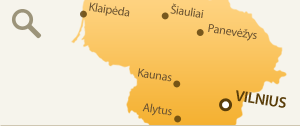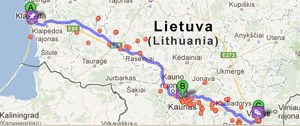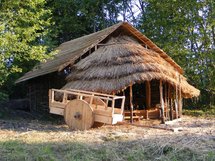Lithuanian ancient culture and Baltic tribes
Lithuanian territory the first people - the hunters - has reached the in the end of the Paleolithic; supposedly, people could live here in the past, but their traces probably destroyed of glaciers. In this period cultural group (tribe) could be around 500 people. Tribe, it is comprised of family communications in the 10 to 20 communities, each of which belonged to the 5-7 families. Family, as defined by the archaeological finds of accumulation could be from 5-7 people. A small number of people surviving due to poor access; there have been pursued seasonal reindeer hunting which took place in their migrations, and food gathering.
Paleolithic culture of Svidrai in the eight millennium of BC first half was changed by mesolithic Kunda culture. This period people lived in small, about 200 - 500 m² place temporary settlements, which were created by rivers and lakes, their locations often changed, but to more convenient for live in a time they always came back. There are known more than 100 villages.
In the 6th millennium of BC when people started to live sedentary people have more time to spend on housing and households, but it became more difficult to provide food, which is driven of a productive economy - agriculture and livestock and pottery - emergence.
In the sixth century in Eastern Europe, with recent rapid spread of Slavic tribes, who from the east, south and west have pressed the Balts tribe, reducing the area occupied by them, starts to stand eastern Baltic tribes, whose names are found in VIII - XV centuries in written sources. At the beginning of this period almost the whole territory of Lithuania was lived by the Baltic tribes buried the dead people not burning them, and in the XII - XIII century custom of burning was everywhere. Agricultural base was agronomy, so very important in the community life was the horse, it or its parts burried with the decedent. Daily life took place in small villages.
To the east of the Middle of Nemunas and the south-east of the Sventoji lived Lithuanian. Their culture formatting dates seeks the third century. Since the sixth century spread custom of burning the dead started to bury them in the various places of burial mounds. Shroud is similar to the previous, only part of them is charred. There are found pottery, spindle, belt buckles, sometimes near the tomb was stud knife or spearhead.
In the Neris and Dubysa lowlands and Nevezis Basin lived tribes have traditionally known as Aukstaiciai. They buried their dead in burial (Marvele, Plinkaigalis, Versvai cemeteries) burnt (didn't burn up to the sixth century), along with the dead was burn and the shrouded (bronze articles melt). To the tomb their put tools (ax, sickle, awl, spindles) and jewelry (collar necklaces, brooches, bracelets), almost undetectable are weapons. Together with the deceased or near it burry the horse - sometimes more than one (there are found up to 8 horses).
In the rivers bathes of Dubysa and Akmena lived zemaiciai, the first time mention in 1294. In their cultural habitat of the dead until the twelfth century they burry in necropolis and didn't burn, well-armed men - in their graves are found a sword, a knife fight, 2-3 spearheads sometimes ax, collars, brooches, bracelets, belt, spur, a horse' body parts: head or leg. Women were burry with a lot of jewelry - necklaces, brooches, beads, diadems, pairs of pins.
Upper of Sesupė, White Ducks and Perseke bathes where Jotvingiai (also called dainaviai and suduviai) tribal inhabited areas. They buried the dead burnt in stones charging barrows. Scanty shroud, weapons found in graves (spearheads, swords), jewelry (brooches, rings, bracelets), pottery.
In Pisa, Isra and Sesupė rivers basins lived nadruviai, referred from the 1254. Their monuments in the territory of Lithuania Minor almost not been studied yet. In Nadruviai graves are found bronze brooches, pottery, iron stirrups, bit and buckles.
On both sides of the Nemunas river, on its right bank between river Mituva and Kamona was the ground of Sklviai. They were referred from 1254. By the seventh century Skalviai didn't burn the dead and later there are found dead, burned graves.
There also were Seliai, Kursiai and Ziemgaliai people. There also found the graves with various objects in their graves. In total, it can be said that there prevailed paganism, and it was believed that the souls of the dead loved ones and continue to live next to the living. For him in the coffin were put various household objects in order he won't be angry on living.
It was believed in various beings: gods, totem, demons, vegetation and wildlife hosts. These creatures were sacrifices that had to guarantee a good harvest and to protect homes, animals. There was also creating various masks and costumes that had to be very scary to scare the evil spirits and various witches, ghosts, because the primitive thought that it protects the homes, crops, livestock, and most of its ills. In sources there are observed agrarian calendar and the holidays, within which was highly respected in the spirit of ancestors, the relationship. In the result there came the belief that the dead farmers and after the death care of their fields that from the same generation of the tribe was working on and the job passed to the offspring. People believed that the ancestors of grace depend on crop yield and tree fecundity. They felt angry that ancestry can destroy crops, burned houses, possessed. Parents and grandparents swear to respect and remember the dead, and it went from generation to generation for many years, even the introduction of Christianity, it was believed ghosts immortality. That's how emerged All Souls' Day, noting like a common prayer for the dead. In the calendar, this day marked on 1-2 November. It was first mentioned in the VII - X century end. Funeral respecting ceremony is based on faith, purportedly relatives of the dead souls continue to live next to the living, and may help or hurt depending on how they are treated. Since then, many conflicting traditions, magic acts and the alleged prevention measures and that had to direct the anger of the deceased. Living dressed unusually, that the dead unidentified them (later it became a mourning clothes). And when they burry deceased they threw stones on it or shooted three handfuls of earth, so that he won't be wrathful. Later to this aim they put on the burried the stones, now there are monuments. In the Pagan Lithuania, so that the deceased won't be angry for him in the coffin put various household items, jewelry, and near the grave burned the fire. They were feasting and the broken glasses. All these ceremonies were performed at the cemetery, called - alkos. Each to his grave offered to the gods and in particular to thunder so that he would take out ghosts of the dead. Also they left food for ghosts, mostly cheese and mead.
Christianity into the agrarian and calendar festivals introduced its elements: fostered gods and goddesses place was taken by Christian saints, magic added with Christian symbols - water, bread, harvest plant celebration in the church. However, the existential implications having farmers rituals, as well as in the past, have been carried to the festive supper table, in cottage or crop fields with the various components of pagan cult.
Holiday traditions and customs were created by the traditional family. The family was quite large, as held from 2-3 generations, and is known as the fellowship or society. These family members worked collectively work was shared between men and women, depending on the age and strength of each. All family members lived in one house or yard, the entire property, food supplies, clothing, work tools were shared. Head of the family was the oldest man, who had very wide powers. He controlled the entire farm property and the maintain order in the family, he was responsible for the behavior of family members. More important affairs of men held talks with the head of the family council of men. An important place was taken by the head of family the wife, usually referred as the queen. Her duties were to take care of home, food and clothing, in addition, she oversaw the domestic hearth, and guarded by religious and traditional customs. Mother had to transfer their daughters, family traditions that they transfer to their children and the generations following generations.
Slowly the large families began to disintegrate and small families were created with their new habits. From there emerged the eldest son preference. He followed his father' after his death he occupies an important place in the home and after escaped to other daughters or married sons, a house was shared in equal parts or paid by any.





